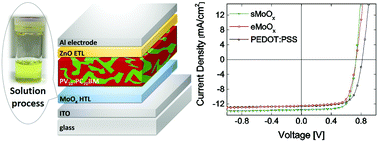Modifying the valence state of molybdenum in the efficient oxide buffer layer of organic solar cells via a mild hydrogen peroxide treatment†
Abstract
Molybdenum oxide (MoOx) films show great potential for use in electrical devices because they display a diversity of valence states of the Mo cation. A simple and mild sol–gel route was developed to synthesize MoOx hole transport layers (HTLs) for organic solar cells to replace the traditional evaporation process for MoOx films, which is difficult to achieve with low-cost mass production. The oxygen vacancies and valency of the Mo in the MoOx HTLs can be well controlled by introducing and adjusting the amount of hydrogen peroxide (H2O2) in the precursors. This method gives MoOx HTLs with a high conductivity, transparency and well-aligned band structure, with the highest occupied molecular orbital in the active layer. The molar ratio of Mo to citric acid in the precursor solution and the annealing temperature of the process have important roles and were optimized as Mo : citric = 0.025 : 0.075 mol L−1 and 200 °C, respectively, for the fabrication of the most efficient solar cells. The performance of the organic solar cells containing the solution-processed MoOx HTLs was comparable with that of reference devices using evaporated MoOx HTLs or poly(3,4-ethylenedioxythiohene):poly(styrenesulfonate) HTLs. HTLs obtained via this route show promise for universal application in a variety of solar cells and provide valuable insights for the production of fast, large-scale, low-cost and renewable sources of energy.


 Please wait while we load your content...
Please wait while we load your content...